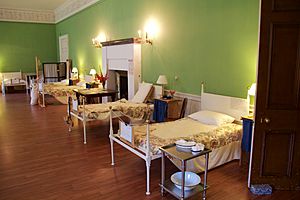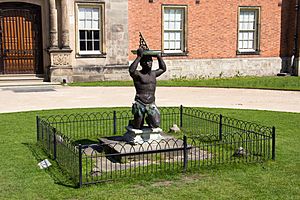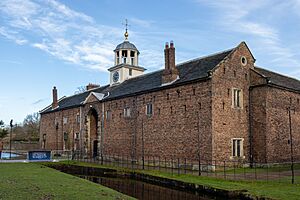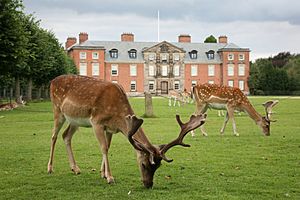Dunham Massey Hall facts for kids
Quick facts for kids Dunham Massey Hall |
|
|---|---|
 |
|
| Alternative names | Dunham Hall; Stamford Military Hospital |
|
Listed Building – Grade I
|
|
| Official name: Dunham Hall | |
| Designated: | 5 March 1959 |
| Reference #: | 1356512 |
Dunham Massey is a grand old house in Greater Manchester, near Altrincham. It's famous for its beautiful gardens and a large park filled with deer. During World War I, it even became a hospital for injured soldiers!
This historic place is officially recognized as a 'Grade I listed building', which means it's very important. Since 1976, the National Trust has looked after Dunham Massey, making sure everyone can visit and enjoy it. The house was rebuilt in the early 1700s and has been changed and updated over many years.
Contents
A Look at Dunham Massey's Past
The first big house at Dunham Massey was built in the early 1600s by Sir George Booth. It took a while to finish, but his grandson, also named George Booth, completed it. He worked hard to make the estate better, even planting trees to sell for wood.
Around 1721, parts of the house were improved, like the stable area. Later, in the 1730s, a new design gave the house its brick look with stone details.
The Booth and Grey Families
When George Booth, the 2nd Earl of Warrington, died in 1758, his daughter, Lady Mary Booth, took over the estate. This was quite unusual for the 1700s! Lady Mary married her cousin, Harry Grey. She helped redesign the beautiful gardens and park at Dunham Massey.
Their son, George Harry Grey, inherited Dunham Massey and other family homes. In the 1780s, he updated parts of the house, including the Great Gallery. His son, also named George Harry Grey, continued to modernize the house in the 1800s.
The 7th Earl, George Harry Grey, faced some challenges. He married women that local high society didn't approve of. Because of this, he moved away from Dunham Massey. The house was then managed by others and sometimes rented out.
Later, the 8th Earl, Reverend Harry Grey, inherited the title but never lived at Dunham. He had moved to South Africa. His third wife, Martha Grey, was a Khoekhoe woman. Even though their marriage was legal in South Africa, it wasn't recognized in England. This meant their son couldn't inherit the title.
Restoring the House
The title then went to William Grey, the 9th Earl of Stamford. He didn't get the estate until 1905. With his wife, Penelope Theobald, they started a big project to restore the house.
From 1905 to 1908, architects and designers worked to make the house look more like it did in the 1600s. Sadly, the 9th Earl died in 1910, just as the family was about to move in.
His son, Roger Grey, became the 10th Earl of Stamford. When he passed away in 1976, he gave Dunham Massey, everything inside it, and the huge 3,000-acre estate to the National Trust. This was one of the biggest gifts the Trust had ever received!
Stamford Military Hospital
During World War I, Penelope Grey, the Countess of Stamford, turned Dunham Massey into a military hospital. It was called the Stamford Military Hospital and operated from April 1917 to January 1919.
The hospital cared for 182 injured soldiers. Their injuries ranged from gas poisoning to bullet wounds, but none were life-threatening. Sister Catherine Bennett ran the hospital, and Lady Stamford's daughter, Lady Jane Grey, even trained there as a nurse.
To remember this important time, from 2014 to 2016, parts of the hospital were recreated. Visitors could see a ward, the operating room, and the nurses' station. Actors also played the roles of people who worked or recovered there.
Amazing Collections at Dunham Massey
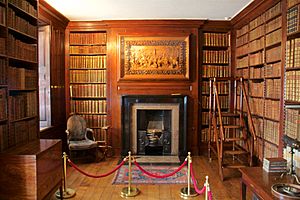
Dunham Massey has a fantastic collection of Huguenot silver. Much of it was collected by George Booth, the 2nd Earl of Warrington, who gathered over 1,000 silver pieces during his 64 years at the house. While some pieces were sold over time, the 10th Earl, Roger Grey, worked hard to bring many family treasures back to Dunham Massey.
You can also see beautiful oil paintings and watercolours. In the Library, there's a special wood carving of the Crucifixion by Grinling Gibbons. This is one of his earliest known works!
There are also paintings of the house and estate from the 1730s, known as the Harris Views. These paintings show exactly what the house and grounds looked like back then. Another important artwork is Allegory of Time by Guercino.
For many years, a life-sized statue of a man holding a sundial stood at the front of the house. This statue was made around 1735. In June 2020, the National Trust decided to move the statue to a different location.
Other Buildings to Explore
The chapel inside the house has beautiful oak panels and silk wall coverings. The house itself is built with brick and stone.
The Carriage House, located near the kitchen, is also a very old and important building. It has a clock turret that shows the date 1721.
Next to the hall are the stable buildings, which also date back to 1721. Today, you can find the Stables Restaurant upstairs and an ice-cream shop below!
The oldest building still standing on the Dunham Estate is the watermill. It might have been built as early as 1616! It was first used to grind corn, then later to cut wood.
Gardens and Deer Park
Dunham Massey has amazing formal gardens and a large deer park. Both the park and gardens are highly recognized for their history. The deer park, which covers 300 acres, has been around since medieval times! It's also a special scientific site because of its old trees.
In 2012, the gardens had over 700 different types of plants, plus 1,600 trees and shrubs. It's home to the largest winter garden in Britain, which is full of snowdrops, daffodils, and bluebells.
During World War II, part of the estate was used as a camp for the US Army and later as a prisoner-of-war camp.
Visiting Dunham Massey
Dunham Massey is a 'Grade I listed building', meaning it's one of the most important historic buildings in England. The National Trust has owned it since 1976. In 2020/21, over 439,000 people visited Dunham Massey, making it one of the National Trust's most popular places!
See also
- Grade I listed buildings in Greater Manchester
- Listed buildings in Dunham Massey


